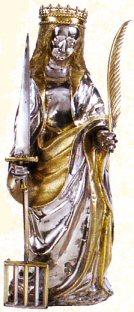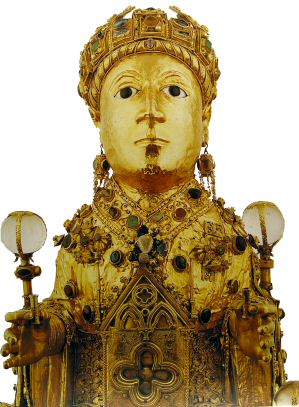
A young martyr
St. Fides, a young Christian from a noble family, lived in Agen in southern France. When she was not even 13 years old, she refused to worship the pagan gods during the persecution of Christians under Emperor Maximinus (303-313). She suffered martyrdom in 303 by torture on a red-hot grate and death by beheading. The legend of her steadfastness in confessing the faith before the Roman judge Dacius (given her youthful age) spread rapidly in connection with the introduction of Christianity as the state religion in the Roman Empire in 313 under Emperor Constantine (Fides = faithfulness). People came regularly to her tomb and Fides became widely known as a martyr. In the 5th century, Bishop Dulcidius of Agen transferred the martyr's relics to a new church he had built. Since the 6th century, veneration can be securely proven. The day of commemoration is 6 October.
Reliquary theft
At the beginning of the 9th century, Conques was a remote little place where a pious man named Dadon had founded a Benedictine monastery that had been insignificant until then. In order to provide a boost, it was decided to procure interesting relics. According to legend, Ariviscus, a monk from the monastery of Conques, moved to the site of St. Fides in Agen and earned the trust of the inhabitants there over many years, so that he - by now appointed guardian of the relics of St. Fides - was able to steal them under cover of darkness sometime between 864 and 875 and bring them to Conques. Another historically plausible explanation would be that after the siege of Toulouse in 862, the Normans advanced far inland on the River Garonne, so that the inhabitants took altarpieces, shrines and significant relics to safety in the hinterland as they fled from the enemies. They may have remained there when the Norman threat had passed. In 883, the relics of St. Fides were officially and solemnly presented in Conques.

Seat reliquary
Apparently, the wooden hull of a seat reliquary of the saint had already been completed at this time. In the late 10th century, the seated figure was reworked and covered with gold and precious stones, with antique gems and cameos ("La Majesté de Sainte Foy"). During a renovation in the middle of the 20th century, the head of the figure turned out to be a reused late antique portrait made of sheet gold. The arms are proven to have been added in the 16th century. The crystal balls of the armrests date from the 14th century. In any case, the wooden core of the seat reliquary contained the head of Fides from the beginning. This relic attracted believers from near and far since the last quarter of the 9th century.
Fides-Cult
Around the same time as the pilgrimage to the tomb of St James the Apostle, the pilgrimage to St Fides flourished and Conques became a staging post for pilgrims. In 1050, a church of imposing dimensions was built in Conques, modelled on the church of St. Martin in Tours - one of the great Romanesque "pilgrim churches" along with St. Sernin in Toulouse and the cathedral of Santiago de Compostela. Wealth came to the remote monastery with the pilgrims. The preserved medieval church treasure of Conques with its precious gold and silver work is today considered the largest outside Rome and the only one in France. The important writings from the beginning of the 11th century on the miracles of St. Fides "Liber miraculorum sancte Fidis" by Abbot Bernard d'Angers were for a time among the most important reading texts of Christianity. Incidentally, this text also reports on the theft of the relics, which was apparently nothing out of the ordinary for the time. St. Fides rose to become one of the most venerated saints in the Middle Ages. With the publication of the "Codex Calixtinus" in the 12th century, Conques became one of the most important stations on the "Via Podiensis". The cult of Fides now spread rapidly along the Camino de Santiago routes. In Burguete near Roncesvalles, a church for the pilgrims of St James was built with the help of the monks from Conques. Even in the choir gallery of the cathedral of Santiago de Compostela, a St. Fides chapel was established. However, this so-called "Capilla de Santa Fe" - consecrated in 1102 - has borne the name "Capilla de San Bartolomé" since the beginning of the 16th century. Two monks from Conques became bishops in Navarre and Aragon respectively towards the end of the 11th century. The influence of Conques was of great importance at that time. But the veneration of Fides also spread towards the countries of origin of the pilgrims of St James. In France, many churches received the patrocinium of St. Faith.
Saint Faith relics reach Switzerland, Alsace and as far as Bamberg
According to legend, Ulrich von Eppenstein (1077- 1121), as Abbot Ulrich III of St. Gall, obtained relics of St. Fides during a pilgrimage to Agen in 1080 or 1085 and built a chapel in her honour in St. Gall. The church of St. Fides, which has often been rebuilt, stands on this site today.
In Sélestat in Alsace, Hildegard of Egisheim (her marriage to Duke Frederick of Büren made them both progenitors of the Hohenstaufen dynasty) had a chapel built around 1087, modelled on the Church of the Holy Sepulchre in Jerusalem, and founded the priory of Sainte Foy there in 1094 with the help of monks from Conques. Hildegard (1025-1095) had made a pilgrimage of atonement to Santiago de Compostela because of an act of blood committed by her son Frederick (the later Duke of Swabia, Frederick I) and had come at least as far as Conques on this journey and invited the monks to Schlettstadt. Possibly the monks had made her understand that her (apparently pompous) journey to Santiago de Compostela would probably be too small a price to pay for a blood debt. In any case, Hildegard bequeathed her Schlettstadt property to the abbey of Conques in 1094. The monks built a first church in Schlettstadt, of which only the crypt still exists today. Between 1152 and 1190, the church was extended to become the Basilica Sainte Foy - today one of the most beautiful Romanesque buildings in the whole of Alsace. The Benedictines from Conques ran Sainte Foy in Schlettstadt as a branch until 1424. "Foy - Fides - Truwe - Getruwen - Getreu" became the Hohenstaufen domestic saint and - along with Odilie - the Alsatian national saint.
The cult of Fides also penetrated the Black Forest to Sölden and Grafenhausen. In Bamberg, Bishop Otto founded a provostry with a church dedicated to Saint Fides (Getreu) in 1123.
